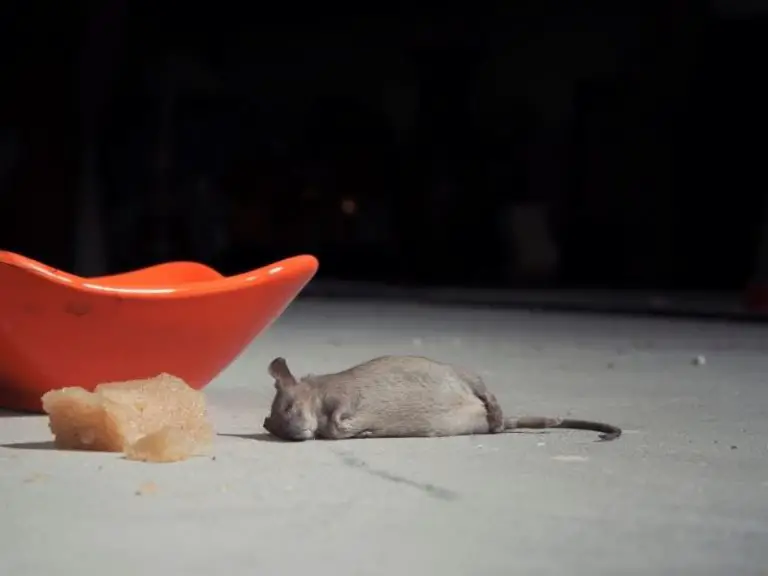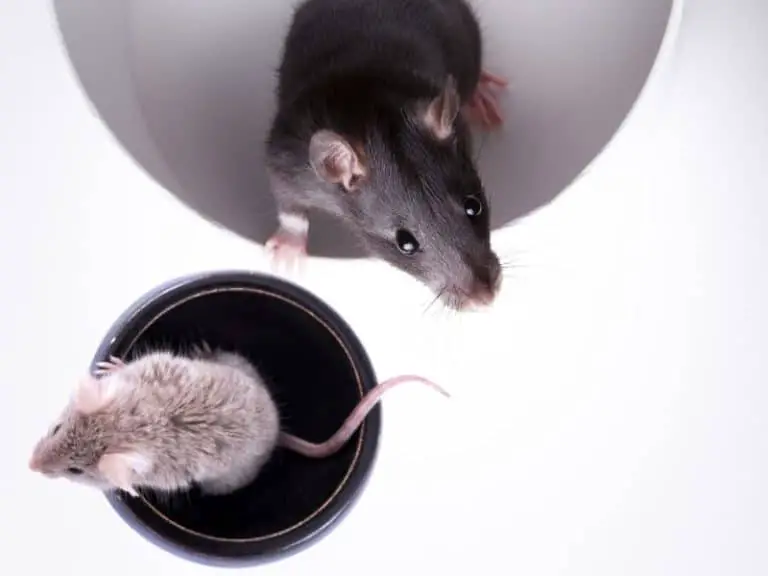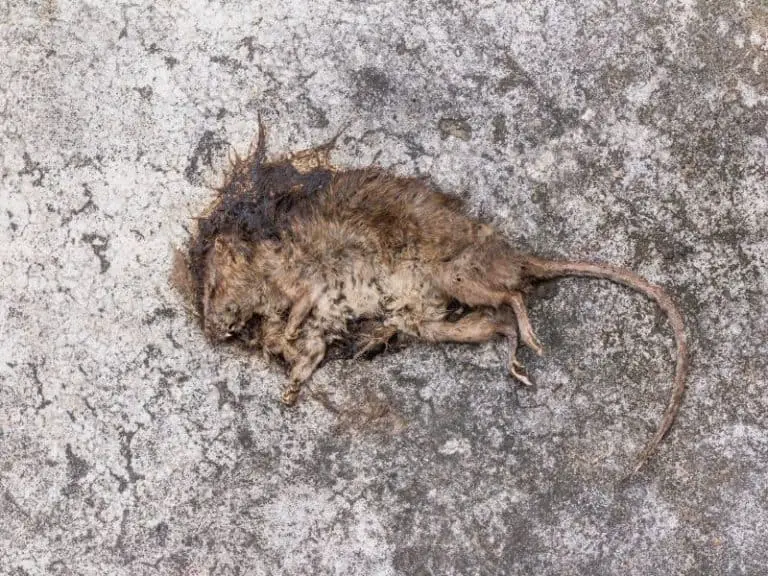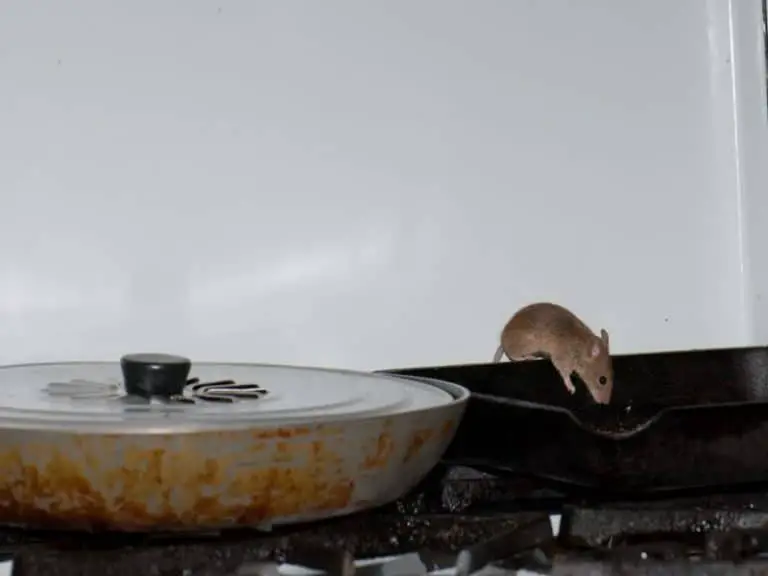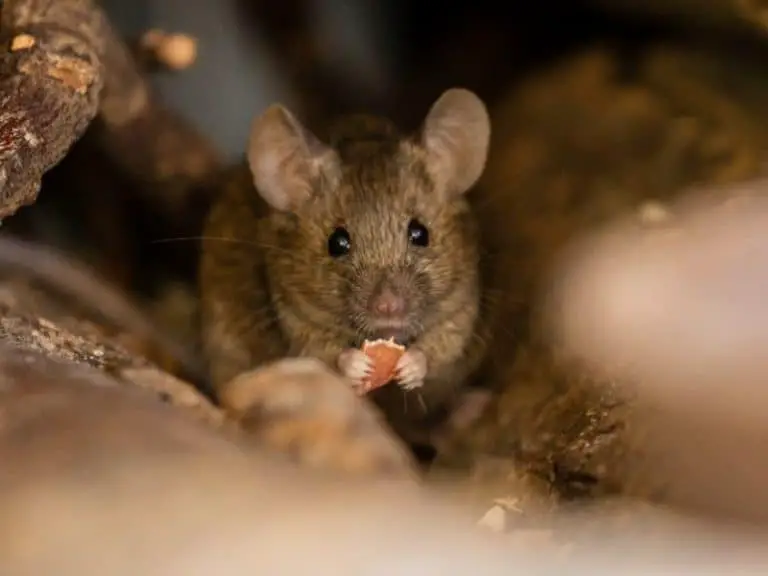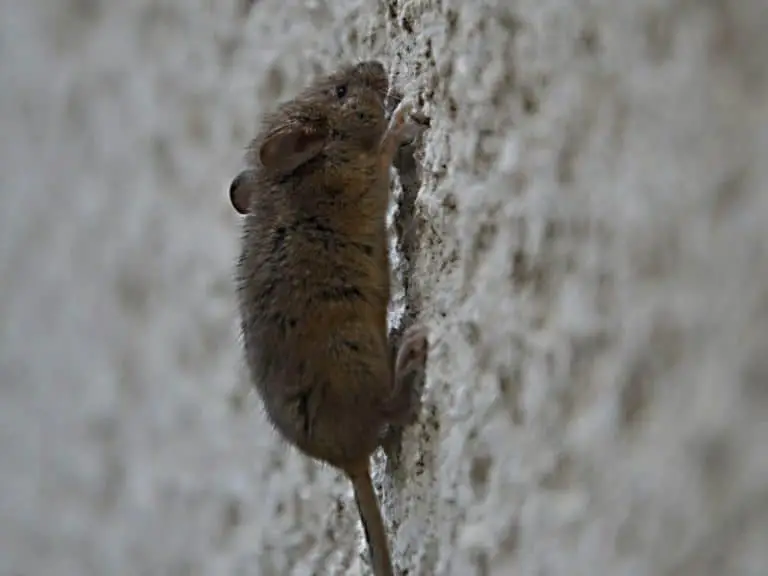How To Get Rid Of Mice In Kitchen Cabinets Properly
Recently, I got a call from a friend to tell me about a situation that she described as ‘absolute horror’. When she walked into the kitchen one morning to make a cup of coffee, she noticed a mouse jump out of the kitchen cabinet, as she opened it to grab the coffee powder.
She had one of her rescue dogs stand by her, who caught the mouse and took it out by the doggy door and set it free.
Although the mouse was out of the house, she spent the entire day tearing apart her kitchen, moving all the electrical appliances, cleaning out the draws to check for mouse-sized holes.
She found nothing suspicious. But, she was only concerned about one thing – “how to get rid of mice in kitchen cabinets” if she found a mouse again in a similar situation.
To get rid of mice in kitchen cabinets start by cleaning and sealing the insides of the cabinet areas. Store all the food items in an air-tight containers. The area under the kitchen sink is the common entryway for a mouse to get in. Close any such holes and cracks with caulk or wire mesh.
Most often, the signs of mice infestation in your kitchen can be subtle. You may find gnawed marks on a steel utensil, chewed marks on a box of cornflakes, or mice droppings in your chinaware.
Sometimes, a mouse may be brave enough to scurry around in front of you while you’re in the kitchen, cooking.
And while you’re in the kitchen, minding your business, and you see a mouse run across in front of you, or worst-case scenario – you find the mouse in the cabinet while you were looking for something to eat, but only to realize the mouse got to it first.
This may make you feel scared, disgusted, angry, and baffled.
What Attracts Mice In The Kitchen Cabinets
Finding mice in the kitchen is one of the most common problems of any home.
Mice are attracted to food, water, warmth, and shelter. And because of the constant threat of predators from outside, mice feel safe and secure at places that are secluded and easy to hide.
Mice are attracted to kitchen cabinets because of plenty of food supply.
Mice aren’t picky with food. They eat everything. So if the kitchen cabinets have exposed foods, open containers of food, open boxes, or anything that’s easy to grab for the mice, it’ll take it.
The best way to avoid this is by transferring all the food items stored in boxes or plastic bags into air-tight or glass containers, which is not accessible to the mice, making it go elsewhere to look for food.
How Do Mice Get Into Kitchen Cabinets
A mouse can jump vertically jump on tables, countertops, and shelves that are about 13 inches from the ground.
This means mice get access to area unimaginable. A little hole, crack or, an opening of about a diameter of a number 2 pencil is enough for the mouse to get in.
The space under the kitchen sink is the most common spot for a mouse to get in the kitchen.
Then they’ll chew through the wood or make their way into other cabinets with tiny openings around by squeezing into the gaps.
Mice can perfectly jump or climb two to three flights of stairs, and more.
What To Do In Case Of Mice Infestation In Kitchen
1. Don’t panic
Breathe. It’s common to see mice infestation in the kitchen even though you’ve got a clean home.
For a mouse, it just means that it has found tasty treats in your kitchen and the mouse took advantage of it.
You can easily fix this problem. Take a few deep breaths and move onto the next step.
2. Find out their entryways.
Mice are clever little critters. A mouse generally needs about 1/4th of an inch gap to make its way into the house.
That’s nearly the same size or the diameter of the number 2 pencil. The mouse features a body structure of flexible ribs and sloped collarbones, making it easy for the mouse to invade your kitchen.
Here’s How To Get Rid Of Mice In Kitchen Cabinets
Close and seal all the gaps and cracks
If you notice any holes, small or big, seal it immediately with steel wool or caulk.
This will stop new mice from coming in so that you can focus on the ones that are already present in the kitchen by getting rid of them.
Make your home uninhabitable for the mice
Keeping food packets or boxes open will seem like an open invitation for mice.
Instead, start storing all the cereals, grains, and other food items into air-tight containers that you know mice can’t chew its way up to the food.
Store all the fruits in a mesh container or the refrigerator.
Keep the kitchen squeaky clean

No matter how tiny a food crumb that’s fallen on the kitchen counter or the floor is, it’s a lot for the tiny and hungry mouse.
So clean up the floors and the countertops immediately after cooking, and do your dishes every night. It’s understandable to be tired after cooking and postponing doing your dishes for the next day.
But doing so, you’re giving mice an easy chance to stay in your home and the kitchen for a longer time.
Find and get rid of the mice nests
After following through all the steps diligently, it’s time to check where the mice have set up the nests.
Once you find these nests, throw it away immediately and sanitize the area thoroughly so that you’re preventing the existing and the future mice from coming again.
Then, you will set up traps near the entry points to catch the ones that are already living there.
Trap the mice by either using humane traps, traps that kill, or by using the bait method. Some of the methods include:
Set up humane traps
Many people aren’t okay with killing mice. And if you’re one among them, know that there are various humane traps you can choose from.
These humane traps don’t kill the mouse. Instead, the traps would keep the mouse alive, but captures, so you can take it to the wild, or far away from home and set it free.
Related Post: Best Humane Mousetraps
Know mice poison
This is the least recommended method to kill mice, because when the mice consume the poison, it’ll sprint off to die, which will make you hunt down the decaying mouse stench coming from within the house.
It’s also a dangerous method to incorporate because if you’ve pets or children at home, they may consume the rodenticide, which is harmful to them.
Related Post: Best Mouse Bait Stations That Are Safe For Kids and Pets
Use electronic deterrents
Along with possessing an acute sense of smell, mice are also known for their hearing. There are certain sounds that both humans and mice can hear.
But the mice or rodent’s range of hearing is superior to that of humans.
So owning a device that generates sounds, which will only be heard by the mice is not only disturbing but also unbearable to these creatures, making mice get away from the area.
Try homemade remedies
Start placing cotton balls that are soaked in either peppermint oil or ammonia near the suspected entryways.
Mice despise the pungent smell of ammonia and peppermint oil and will leave the area if it thinks it’s coming close to the smell.
Adopt a cat
The best way to keep mice, rats or any other rodents at a mile’s distance is by adopting a cat – the natural predators to mice. Also, they make lovely companions.
Do not use mothballs
For some reason people believe that mothballs repel mice and rats. Apparently, this is not true. Several big pest control companies dispelled this common myth.
Signs Of Mice In The Kitchen
Most often, mice make it clear they’re in the kitchen by making their presence known.
But sometimes, they leave subtle signs behind, which can be quite dangerous if ignored.
The most common sign and a counterintuitive one is the mice droppings. This means that mice have found shelter in the kitchen, where food can be found.
And these droppings carry a lot of diseases and can be spread to the food mice come in contact with. The disease won’t stop in the kitchen. It’ll go beyond the kitchen and whatever mice come into contact with.
The other sign would be the biting/chewing/gnawing marks and scratches in and around the food storage areas including, boxes of cereals or pasta, bags of flour, vegetable and fruit crates, etc.
If there are major signs where human food or pet food is being destroyed or contaminated, consider storing all the food or consumable items in secure storage spaces or storing them in glass and air-tight containers.
Also, dispose of any food items that have been disposed to the mice, as there are high chances of them being contaminated.
Can Mice Open Cabinet Doors
Mice don’t find the need to open many doors for them to get inside.
If the cabinet doors in the kitchen are held in place with a magnet or a latch, a mouse wouldn’t have enough weight, force, or strength to open the door. Mice aren’t aggressive pests to be using any form of force.
To access ground-level cabinets, a mouse needn’t open any doors.
When a house is being constructed, the builders and contractors rarely finish or work on the walls thoroughly that they know is going to be hidden behind the cabinets.
It takes time and effort to do polished work and to seal off everything correctly.
In reality, no one pays attention to the drywall or how it looks under the kitchen sink. If it’s noticed, it isn’t taken into consideration.
Because of these reasons, gaps are found in the unfinished areas. Mice are secretive. They like to be hidden. Hence, they can traverse through any cracks or holes that are no larger than a dime easily.
So if there are ground-level cabinets in the kitchen, mice can get into it from beneath the cabinet area.
Signs Of Mice In The Kitchen But No Droppings
Normally, when there is a mouse in the house, there will be signs of mouse droppings. But, not always. There may be mouse droppings in the areas where it can be overlooked.
Mice are adept. They climb by making use of the structures and elements in and under the cabinets to move around.
Because of this, a mouse can get around everywhere, including the top of the refrigerator.
The most common signs in the kitchen area are in the cabinets and under the sink.
Notice any holes in the pipes or other areas where mice can gnaw its way in. It takes around the size of a dime or a quarter for a mouse to get inside.
The next area to look for signs is beneath the stove.
A human nose can sense a distinct smell and the one that is not used to. When mice, rats, or rodents urinate, it exudes a very distinctive yet musty odor.
Once this odor is recognized, it’s a tell-tale sign of that of a mouse, rat, or rodent in the house.
Ways To Mouse-Proof Kitchen Cabinets
The best way to mouse-proof cabinets is by storing away attractants, sanitizing the area, and sealing off entry points to the kitchen, cabinets, and home, eliminating all the conditions for mice infestation.
The following are some of the basic and simple steps to stop mice from getting into the kitchen and to the house.
Use proper storage containers
Although you may forget about food and other consumable items, the mice surely wouldn’t forget about them.
And making sure all your storage units are thoroughly examined is a primary step in getting rid of mice in kitchen cabinets.
- Store all the disposed food items, pet food, birdseed, and dry food in glass or other airtight containers.
- Seal all the storage items properly to eliminate mice nesting.
- Avoid storing any food items in cardboard boxes that can be accessed easily by the mice that are nesting.
- Store all the food essentials on the pallets or shelves.
Related Post: Best Storage Containers to Keep Mice Out
Sanitize every area
To avoid mice infestations, thoroughly sanitize the entire area.
Usually, the kitchen is the place where mice thrive because of easy access to food and shelter. When you remove these two factors, you remove the problem of mice infestation.
Clean your kitchen thoroughly and the rest of your home, too. Sanitize every nook and corner, and even behind the walls.
When you clear away the nesting areas and sanitize any fecal matters – you avoid the chance to get future infestations.
Indoors:
- Clean your kitchen thoroughly, especially the areas where food crumbs are present, like the dishwasher, under the stove, refrigerator, countertops, tables, etc.
- Don’t leave water in open glasses for a long period.
- If you own pets, remove any uneaten food and keep the area spick and span.
- Cover any garbage cans or trash cans with a tight lid.
- Clean up areas with moisture in it regularly.
Outdoors:
- Mow your lawn regularly to eliminate all the hiding spots.
- Trim all the overgrown vegetation until you see the ground underneath.
- Collect all the fruits that have fallen in your yard from the trees you’ve planted.
- Clear out the debris, including old equipment, unused cars, rock piles, etc.
- Store wooden logs away from the house and off the ground.
Seal all the openings
The best way to keep control of mice infestation is by making it nearly impossible for the mouse to enter the kitchen or home.
It is difficult to eradicate them without the help of a pest technician, but you can always take measures to control their movement from entering.
As mentioned earlier, mice can squeeze through half an inch opening – this is usually the size of a dime or nickel. Start by inspecting the most-common access points of the mice and seal them.
- Mouse-proofing materials: Steel wool, caulk, concrete, wire mesh (copper or aluminum), sheet metal, hardware cloth.
- Common entry points: Repair and seal all the cracks, holes, and gaps found within pipes, walls, basement, doors, window frames, etc.
- Caulk holes under the kitchen sink and pipes that lead to electrical appliances.
- Cover up all the insulation points that mice may find as a warm space for nesting.
- Cover the chimney with a cap to prevent mice from entering through there.
Call in the professionals
If all else fails, and you still find signs of mice in the kitchen, or in the house, call in the professionals who are experienced in getting rid of mice infestation for good.
They will sanitize, exterminate, and clean all the nesting areas, fecal matters, and leave no mice or their smell behind, so you’re free of all the present and possible future infestations for good.
Related Post: When to Call an Exterminator For Mice
Natural Ways To Keep Mice Out Of Drawers

The simple scent of peppermint oil in the corners of drawers and other areas will work in getting rid of mice. Having mice at home isn’t a pleasant experience.
They spread diseases and create dangerous situations at home. And using mouse traps isn’t the only way to getting rid of them.
These are some of the natural ways of keeping mice out of drawers:
Peppermint Oil
You can use this method in three ways:
- Invest in peppermint plants and keep them both indoors and outdoors.
- Spray the peppermint oil in the drawers and at different areas of your home where mice can enter.
- Soak peppermint oil in cotton balls and place them within the drawers, in the kitchen cabinets, and other parts of the home.
Instant Potatoes
Sprinkle a few spoons of instant potatoes in the drawers and other areas where mice frequent.
Mice love the taste of instant potatoes, but the flakes of this mix are dangerous when consumed by the mouse.
The flakes expand in the mouse’s stomach and will kill it before it’s digested fully.
If you’ve pets at home, be aware of how you use it around them, and make sure they’re out of reach from the pets.
Onions
Another pungent smell on this list that mice despise is that of onions.
Although this remedy works, it is a bit tricky on how you use them because,
- Onions rot if they are left out for multiple days.
- They’re also toxic to cats and dogs.
The odor of onion will have mice keep their distance and run the other way.
But, if you’re using onions to repel mice, keep it out of reach from pets, and place freshly sliced onions every other day until you get rid of mice permanently.
Cocoa powder and plaster of Paris
This method of mixing plaster of Paris and cocoa powder came from a woman who lived in Catskills, on a farm.
For this method:
- Mix cocoa powder with dry plaster of Paris.
- Sprinkle the mixture within the drawer and other areas where mice frequent.
- Chocolate is one of the favorite treats for mice and it will be attracted to the ingredient and eat it.
- After they consume it, mice will run outside in search of water and eventually die.
Cat Litter
Sprinkle used cat litter in the drawer, surrounding areas, and the common mice entry points for the mice to flee.
Mice can have a strong sense of smell of their predators and will not stay around in your home for long. That being said, you could also just adopt a cat.
Conclusion
It’s baffling how much effort and time it takes to get rid of these tiny critters.
Although they’re fairly harmless, the droppings they leave behind can be a spreader of dangerous diseases. And it’s not healthy or good to have them raiding in your kitchen every night.
With this article, hopefully, you’ve got an idea of how to get rid of mice in kitchen cabinets.
Some people however may find another article useful and practical:
11 Ways to Scare a Mouse Out of The Room
Photo credit: ©canva.com/madeleine_steinbach, ©canva.com/andreypopov
Medical Disclaimer: TheHomePestControl is a digital publisher and does not offer personal health or medical advice. The contents of this website are not intended to substitute for professional medical advice, diagnosis, or treatment.
Affiliate Disclaimer: As an Amazon Associate, I earn from qualifying purchases made on our website. If you make a purchase through links from this website, I may earn a commission at no additional cost to you.

